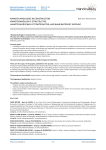Nanotechnologies in Construction: A Scientific Internet-Journal @nanobuild-en
Статьи журнала - Nanotechnologies in Construction: A Scientific Internet-Journal
Все статьи: 572
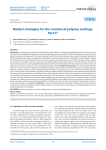
Modern strategies for the creation of polymer coatings. Part II
Статья научная
Introduction. Coatings on hard materials are widely used in many industries. Coating technologies help prevent or reduce corrosion, contamination and biofouling, chemical and structural degradation, and wear and tear of external surfaces due to exposure to the elements and natural environments. The range of materials used for functional coatings is wide enough: from organic polymers to hybrid composites and inorganic nanoparticles, depending on the desired properties and functionality of the final product. Despite the excellent anti-corrosion characteristics of non-polymer coatings, their usage causes environmental damage. Organic coatings are among the most widely used. Such compositions are applied in liquid form; organic solvents are one of the major components. Environmental concerns have encouraged the development of alternative technologies. The main areas for development are availability of raw materials and the cost of environmentally friendly coatings. Results and discussion. The review substantiates the relevance of research on the development of multifunctional polymer-based coatings. The market for polymer coatings is presented. Methods of surface protection, types of coatings formed, their main components, features of the formation of coatings, the influence of various factors on the formation of polymer coatings, including methods of preparation and pre-treatment of the protected surface are presented. Methods for preventing corrosion are discussed in detail, as well as the primary lines in the development of anti-corrosion coatings based on various protective mechanisms. The characteristics of the main components of protective coatings are given. The issue of destruction of polymer coatings depending on the operating environment is considered in detail. The types of media, their influence and mechanisms of action on protected objects are considered. Factors and mechanisms of destruction of polymer coatings, methods for preventing degradation of coatings are listed. The latest technologies for the formation of protective polymer coatings are highlighted. Conclusion. Currently, coatings provide a wide range of quality indicators. An important characteristic of modern coatings is minimal negative impact on the environment, which requires an integrated approach to the design and production of coatings.
Бесплатно
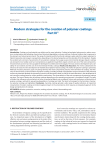
Modern strategies for the creation of polymer coatings. Part III
Статья научная
Introduction. Coatings on hard materials are widely used in many industries. Coating technologies help prevent or reduce corrosion, contamination and biofouling, chemical and structural degradation, and wear and tear of external surfaces due to exposure to the elements and natural environments. The range of materials used for functional coatings is quite wide: from organic polymers to hybrid composites and inorganic nanoparticles, depending on the desired properties and functionality of the final product. Despite the excellent anti-corrosion characteristics of non-polymer coatings, their usage causes environmental damage. Organic coatings are among the most widely used. Such compositions are applied in liquid form; organic solvents are one of the main components. Environmental concerns have encouraged the development of alternative technologies. The main areas for development are availability of raw materials and the cost of environmentally friendly coatings. Results and discussion. The review substantiates the relevance of research on the development of multifunctional polymer-based coatings. The market for polymer coatings is presented. Methods of surface protection, types of coatings formed, their main components, features of the formation of coatings, the influence of various factors on the formation of polymer coatings, including methods of preparation and pre-treatment of the protected surface are presented. Methods for preventing corrosion are discussed in detail, as well as the main directions in the development of anti-corrosion coatings based on various protective mechanisms. The characteristics of the main components of protective coatings are given. The issue of destruction of polymer coatings depending on the operating environment is considered in detail. The types of media, their influence and mechanisms of action on protected objects are considered. Factors and mechanisms of destruction of polymer coatings, methods for preventing degradation of coatings are listed. The latest technologies for the formation of protective polymer coatings are highlighted. Conclusion. Currently, coatings provide a wide range of quality indicators. An important characteristic of modern coatings is minimal negative impact on the environment, which requires an integrated approach to the design and production of coatings.
Бесплатно
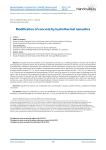
Modification of concrete by hydrothermal nanosilica
Статья научная
The paper shows the possibility to use hydrothermal nanosilica as a modifying additive to increase the strength of concrete based on portland cement. The technology of obtaining hydrothermal nanosilica in the form of sols and nanopowders by ultrafiltration membrane concentration and cryochemical vacuum sublimation is proposed. The results of increased strength of concrete under compression by the addition of hydrothermal nanosilica Sol are presented. The experiments were performed on highly mobile concretes (ST = 10–19 cm) on equal-moving mixtures with water-cement ratio W/C = 0.61–0.71 at a dose of SiO2 2 wt.% and the rate of superplasticizer polycarboxylate 0.95±0.05 mas.% by cement. At the initial stage of hardening when the age is 1 day, the increase in the compressive strength of concrete reached 90–128% compared to the control sample. At the age of 28 days the increase in strength was 40%. High chemisorption activity of hydrothermal nanopowder with respect to Ca(OH)2 was determined in the experiment with lime medium. This indicates that the amorphous nanoadditive SiO2, which has a high specific surface area, causes the formation of high-strength hydrates of calcium silicates in the cement (lime) medium as a result of the pozzolan reaction, and this causes an increase in the strength of concrete.
Бесплатно
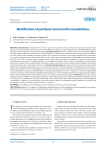
Modification of portland cement with nanoadditives
Статья научная
Introduction. Portland cement slurries (suspensions) used for well cementing have high water-cement ratios (0.45–0.6). They also contain a minimum amount of inert fillers, must have zero water separation and controlled hardening with a minimum time between the start and end of setting. Literature review. Most of the scientific work on the use of nano-additives in binder systems relates to the construction industry. Nanosilicon, nanotitanium, nanocarbonate, nanoclays, carbon nanofibers, etc. were widely used as modifiers of cement systems, which showed an increase in the strength characteristics of the resulting concretes. Literature review showed that there is a very wide range of concentrations of nanoadditives in cement systems from 0.001 to 10.0%. An increase in the strength of cement with high concentrations of additives in a number of publications is explained by a decrease in its capillary porosity due to clogging of the pore space. However, nanoadditives should not play the role of microfillers in the hardened stone. They should work in cement slurry at the stage of cement hydration and cement structure formation at concentrations less than 1.0%. Results and Discussion. The paper presents the results of experimental studies of the rheological properties and early strength of stone based on Portland cement with additives (0.01%) of nanocarbonate and nanoiron. The role of nanoadditives is to increase the rate of cement hydration by reducing the activation energy, and accelerating the dissolution of the solid phase in the liquid. Nanoadditives can be a “substrate” on which two-dimensional nuclei of a new phase are formed. The probability of the appearance of two-dimensional nuclei on the substrate is much higher than for the formation of three-dimensional nuclei of a new phase in the bulk of the solution. Conclusion. The results show an ambiguous effect of additives on the tested parameters, which indicates the need to optimize the amount of additives. One of the reasons for the ambiguity of the results may be high water-cement ratios, which reduce the likelihood of the formation of “constrained” conditions in cement slurries. At the same time, the effects of accelerated cement hydration are “levelled” and the number of contacts between hydration products is reduced.
Бесплатно
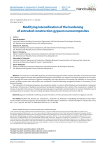
Modifying intensification of the hardening of extruded construction gypsum nanocomposites
Статья научная
The processes of controlled hardening of nanomineral gypsum binders and the formation of microstructure that allow obtaining gypsum concrete with specified technological characteristics are analyzed. Innovative approaches to the regulation of strength and water resistance of gypsum nanobinders, the main directions of increasing their durability in concretes and mortars, building constructions and products are considered. Controlled hardening nanogypsum binders is a promising 3-D additive technology. The mechanism of hardening of gypsum nanocomposites based on calcium sulfate dihydrate and semihydrate is proposed. The kinetics of the process of hydration and setting of nanobinders depending on the content of the components is studied. The increase in strength in the process of hardening of pressed gypsum nanobinders is determined by the content of dihydrate and is accompanied by an increase in the size of needle and plate microcrystals with a thickness of less than 100 nm.
Бесплатно

Nanocoatings in modern construction
Статья научная
The review analyzes the state of the nanocoating market, shows main types of nanocoatings, as well as drivers and barriers to their development and application. Modern progress in the field of nanotechnology allows us to attribute nanocoating to high performance materials, the structure and properties of which can be “designed” according to specific functional criteria and the level of environmental impact. They present unique remarkable characteristics compared to conventional coating materials in construction industry. The government’s grandiose plans to commission new housing and road infrastructure, as well as ambitious projects to develop the Arctic and ensure national security, should lead to the growth of the industry as a whole, as well as to an increase in demand for more efficient, innovative building materials, including nanocoatings and nanopaints.
Бесплатно
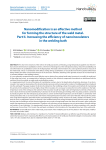
Статья научная
The short-term existence of the melt in the weld pool and its overheating, a large temperature gradient near the interface and two-dimensional crystallization centers, in the form of fused grains at the weld pool boundary, reduce the probability and rate of formation of crystallization centers in the liquid phase. This leads to the formation of a coarse-grained columnar structure of the weld metal, which, in combination with defects arising during crystallization, is less ductile than the fine-grained rolled metal being welded, and often causes brittle fracture of the structure. Therefore, obtaining a fine-grained structure of the weld metal is a constant problem in the welding industry. It is now generally accepted that the most effective way to obtain a fine-grained weld metal structure is to modify the weld pool. At the same time, micro- or nanoparticles of refractory metals or their chemical compounds (inoculators) are introduced into the weld pool from the outside, as ready-made crystallization centers. In a superheated melt, the rate of formation of crystallization centers, due to the deactivation of particles, decreases. It can be increased in two ways: by slowing down the decontamination process and by increasing the number of modifying particles introduced into the weld pool. The paper analyzes the factors that determine the modifying activity of inoculators and methods for maintaining this activity in the weld pool. To ensure high activity of the inoculator, it is necessary to reduce the time of its residence in the hightemperature zone of the weld pool; the material of the inoculator should have high values of temperature and heats of fusion, but lower values of thermal and thermal diffusivity. A decrease in the rate of heating and melting of the inoculator particles is achieved by introducing them into the weld pool, by passing the arc column and the high-temperature zone of the bath, in combination with metal particulates that act as microcoolers and means of transporting the inoculator to the tail of the bath. Nanoscale inoculators have a high thermodynamic potential and the associated high nucleating activity. Inclusions of oxides, carbides and nitrides, on the basis of which crystallization centers are formed, in the solidified metal have strong interatomic bonds with the matrix, and due to the fact that the coefficients of their thermal expansion are an order of magnitude lower than those of the matrix, after cooling the metal, they experience all-round compression. Therefore, such inclusions are not dangerous, are not concentrators of tensile stresses and centers of crack initiation. It is experimentally shown in this work that the introduction of carbon nanotubes with a specific surface area of more than 270 m2/g into the weld pool contributes to the formation of a fine-grained structure of the weld metal.
Бесплатно
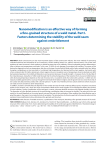
Статья научная
Steel constructions are the most important objects of the construction industry. The main method of connecting individual elements and assemblies of such structures is fusion welding (electric arc, plasma, electron beam). One of the main problems of metal structures is their tendency to brittle fractures that occur suddenly, without noticeable previous deformations, often at below zero temperatures and loads. In this case, 70–80% of such damage is associated with welding. The nature of the destruction depends not only on temperature, but also on the type of crystal lattice. Metals with a body-centered cubic (bcc) lattice (tungsten, molybdenum, α-iron) are plastic at a relatively high temperature, but become brittle when negative. And metals with a face-centered cubic (fcc) lattice (aluminum, nickel, copper and γ-iron) are plastic even at temperatures close to absolute zero. With decreasing temperature, the mobility of dislocations and vacancies decreases, the yield strength σs increases, that is, the ductility of the metal decreases. Using the A.F. Ioffe model showed that the critical temperature of the transition from viscous to brittle fracture with decreasing temperature depends on the rate of increase of σs. In austenitic steels (fcc lattice with a period a = 0.3645 nm), the impurity mobility (paired with a vacancy) through the internode of the lattice is higher, and the growth rate σs is lower than that of low-carbon low alloy steels (bcc lattice with a shorter period a = 0, 2861 nm). Therefore, the low carbon steels from which structures are made are more sensitive to lower temperatures. In addition, resistance to brittle fracture depends on the number and size of metal continuity defects (pores, inclusions, low-plastic phases in the structure, etc.), which are stress concentrators. Welds are the main suppliers of such dangerous defects and sources of crack initiation. During crystallization of the weld pool, a coarse, columnar dendritic structure with reduced ductility is formed. The formation of a fine-grained structure of the weld during crystallization helps to increase its ductility. The grain size in the cast metal (in the weld) depends on the crystal growth rate and the rate of their nucleation. When welding, the most effective way to grind the grain in the seam is to increase the rate of nucleation. The introduction of refractory particles of nanoscale order into the weld pool (nanomodification) allows obtaining a fine-grained weld structure.
Бесплатно

Nanomodification of cement-based composites in the technological life cycle
Статья научная
The paper reviews the theoretical framework of nanomodification principles of building composites and the conceptual model of the nanomodification from the point of view of the evolutionary model of the solid phase formation depending on the kinetics of heterogeneous processes. According to the route, the main factors of the cement system nanomodifcation were identified for all stages of the technological life cycle. These are associated with the nano-sized particles playing the role of a) structure-forming nuclei, b) substrates for crystallization, c) centers of new formation zoning in the matrix substance of the material, d) nano-reinforcing matrix element. The concepts of the nanomodification and technological tools of the nanomodification of building composites are substantiated. Their hydration kinetics, phase composition, microstructure, rheology and strength characteristics are investigated in order to evaluate the efficiency of the nanomodification principles. It is shown that the use of the nanomodifiers enhances the ductility of cement paste, accelerates cement hydration processes by 9–28 times, and increases strength by 1.5–2 times. This will reduce the cost of flow, casting and hardening processes in the technological life cycle of cement-based composites.
Бесплатно
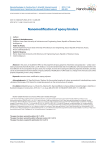
Nanomodification of epoxy binders
Статья научная
In this work, we studied the effect on the properties of epoxy polymers of domestic nanoproduction – carbon nanotubes produced by NanoTechCenter LLC (RF, Tambov). It has been determined that the modification of functionalized CNTs is the most effective in the composition of epoxy resins, for example, in terms of increasing the adhesive properties of binders, and they can be recommended in the formulations of epoxy adhesives. Modification of CNTs leads to a change in the microstructure of the polymer, depending on the curing conditions.
Бесплатно
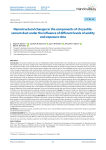
Статья научная
Introduction. The article considers the issue of modifying the initial chrysotile fiber and its bundles by the action of hydration products of Portland cement and various acidity value of the treated medium. A brief justification of the relevance of the research topic is provided. It is noted that recently, issues of production of composite materials based on natural and man-made raw materials, which are a promising area of modern economics, have aroused great scientific and practical interest. The availability and low cost of raw materials, as well as low energy, transportation, and overhead costs, contribute to reducing the cost of composite materials. At the same time, the high contractual prices and strong demand in both domestic and foreign markets provide incentives for increasing production volumes. The aim of the research is to study the behavior of the initial chrysotile fibers and their aggregates in the composition of the cement component under the influence of different acidity of the treated medium. Research objective: to investigate the behavior of chrysotile cement dust components under an aggressive environmental condition with electron microscopy examination; calculation of the number and dimensional characteristics of nanofibers and dust particles under the influence of various exposure times of the aggressive factor; microdifraction studies of the nanostructure of the studied samples after exposure to acidic media. Materials and methods. The materials used in the research and their characteristics are given, in particular, chrysotile cement dust containing fibers of commercial chrysotile, acidity of the medium, exposure time, micro- and nanofibers obtained after exposure to aggressive medium. Samples of chrysotile cement dust were taken at the slate production No.1 of JSC “BelACI” and collected at the place of sawing of chrysotile cement products, underwent the stage of dispersion using a centrifugal separator. In the work chrysotile cement dust was used as an object of environmental pollution and its further use in the production of composite chrysotile cement products. Results. The results of studies on the influence of aggressive environment on the components of chrysotile-cement dust, their size characteristics, and structural nano-changes are presented. The studied samples have been examined in a scanning ion-electron microscope at magnifications of 200x, 500x, 5000x, 10000x, and their chemical composition have been analyzed. Discussion. The results of analysis of the obtained experimental data are given. Quantitative composition of fibers and aggregates of fibers in chrysotile cement dust changes after its exposure in acidic medium in comparison with their quantity in initial chrysotile cement dust, and the quantity of separate thin fibers increases, it is explained by the fact that in acidic medium there is not only destruction of cement stone, but also splitting of bundles of chrysotile fibers into micro- and nanofibers. Conclusions. Electron microscopic examination of initial commercial chrysotile fibers and their bundles in cement dust have shown changes in their dimensional and quantitative characteristics, including the products of Portland cement hydration under the influence of the factor of aggressiveness of the environment.
Бесплатно
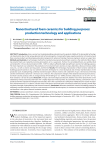
Nanostructured foam ceramics for building purposes: production technology and applications
Статья научная
Introduction. Foam-ceramic heat-insulating building materials have the greatest stability of the demanded technological characteristics due to their unique physical and technical properties. Increasing the large-capacity production of nanostructured foam-ceramic products and developing educational programs for advanced training of process engineers remains an urgent task. Methods and materials. A technological method for manufacturing nanostructured foam ceramics is the method of direct foaming: ceramic foams are created by involving atmospheric air in a suspension. Further, the consolidated foams are carefully dried and sintered for 12 hours by heat treatment (950–1100оC) to obtain sufficiently high-strength foam ceramics for building purposes. The most important raw materials for the production of construction foam ceramics are clays, diatomites, siliceous minerals, zeolite rocks, etc., as well as ceramic and slag waste, and the like. Results. The technology of production of foam-ceramic materials for building purposes based on clay raw materials has been developed. As a result of physical and chemical transformations in the production cycle, including firing, uniformly closed micropores of foam ceramics with a diameter of up to 120 microns are formed, and the wall thickness varies from 1.8 microns to 6.3 microns. The compressive strength of the obtained nanostructured construction foam-ceramic products with an average density of 450–850 kg/m3 is 3–8 MPa, thermal conductivity is 0.12–0.15 W / (m●оC), frost resistance is at least 50 cycles. Discussion. In large-scale technological production, bubbles mass (three-phase foam) can be obtained by mixing nanostructured foam with a highly dispersed mineral powder. By controlled sintering, a dried foam mass is produced with the required technological characteristics due to the crystal bond of a solid-phase mullite based on cluster microparticles with dimensions of 15–200 nm, and the walls of micropores and nodal joints of nanostructured foam ceramics provide high mechanical strength, hydrophobicity and chemical resistance. Conclusions. Nanostructured foam ceramics for building purposes is sufficiently moisture-resistant, since it has a microstructure of closed ultramicropores; it is resistant to chemical and physical effects and therefore is the optimal thermal insulation material.
Бесплатно
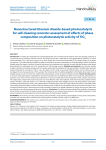
Статья научная
Introduction. Currently, the development of photocatalytically active cement-based materials with self-cleaning properties is a promising area of building materials science. Self-cleaning concrete is obtained by using photocatalytic additives, of which titanium dioxide (TiO2) is the most common. It has been found that the functional properties of TiO2 depend largely on its phase composition. This study aimed to establish the patterns of influence of phase composition on the photocatalytic activity of titanium dioxide under the impact of artificial ultraviolet and natural solar radiation and to identify the most effective titanium oxide-based photocatalysts for subsequent use in the composition of self-cleaning concrete. Methods and materials. Four titanium dioxide samples, namely two industrial samples and two samples synthesized by hydrolysis of titanium alkoxide in acidified water-alcoholic medium followed by calcination at 500 °C, were the objects of the study. X-ray powder diffractometry was the method used to investigate the structure parameters of TiO2 samples. The model reaction of oxidative degradation of methylene blue under UV- and daylight exposure was the means for studying the photocatalytic activity of titanium dioxide samples. Results and discussion. It was found that polymorphic modifications of titanium dioxide had a multidirectional effect on its functional characteristics, in particular, a rise in the content of anatase and rutile led to an increase and decrease in the photoactivity of TiO2 samples, respectively. The single-phase sample with anatase structure was most effective under UV irradiation, while the three-phase sample with the anatase : brookite : rutile ratio of 67% : 13% : 20% had the highest activity under daylight exposure. The photocatalyst composition, including several polymorphs of TiO2 with a predominance of anatase form (more than 50%), allowed to achieve a synergistic effect of increasing the photocatalytic activity of titanium dioxide under conditions of solar radiation due to the formation of type-II semiconductor heterojunctions. Heterostructures made it possible to improve the spatial separation of charge carriers and to reduce the recombination rate of photogenerated electron-hole pairs. Conclusion. The obtained results indicated the possibility of improving the functional characteristics of titanium oxide-based additives for self-cleaning concrete due to the targeted regulation of their phase composition by optimizing the synthesis parameters of photocatalytic modifiers.
Бесплатно

Статья научная
Introduction. The aim of the study was to optimize the quality control of fire retardant coatings (FRC) during their production and use. The results of a comparative analysis of the consequences of fires and their causes with the parameter of fire resistance of objects indicate that the number of fires and damage from them in buildings of the first degree of fire resistance is almost an order of magnitude smaller than in buildings of the second degree of fire resistance. Consequently, increasing the fire resistance of building materials and structures is the way to radically reduce fires and losses from them. Methods and materials. Based on a system analysis of existing fire protection technologies for building materials made of wood, metals, rubber and polymers, nanotechnologies were developed to determine the stability of samples with an FRC on the baro-electro-thermo-acoustic (BETA) analyzer and create their «images» for further diagnosis of their aging at the constructions and operation facility. The novelty of the study is protected by patents of the Russian Federation. Results and discussion. The obtained results consist in the refinement of computational algorithms for the FRC in the BETA analyzer, as well as in the development of a portable automated complex, which allows to determine the stage of «aging» of the FRC on these materials, and, consequently, their durability and update time. This conclusion is based, firstly, on the results of the development of a thermo-electro-dilatometer crucible for controlling liquid and viscous materials by the authors of the «float design», which will make it possible to control the FRC characteristics during their production, and secondly, to carry out express control after filling them in containers (polymer, metal, glass) without opening it and thirdly, due to the recognition of these «images» using thermo-electro-measurements of the FRC using special probes connected to a portable automated system. Conclusion. The results obtained make it possible to «arm» with portable automated systems not only construction and fire control authorities, but also manufacturers of emergency protection products. This will allow, according to the authors, to fundamentally solve the problems of quality and durability of FRC, but the main thing is to guarantee the stability of the protected materials and structures from them.
Бесплатно
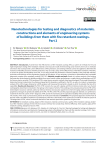
Статья научная
Introduction. To determine the effectiveness of fire-retardant coatings (FRC), a system of methods for fire and high-temperature testing of fire-retardant materials and structures made of themis being used. However, there are no methods and means that could provide current effectiveness of fire protection, and existing methods cannot be applied to determine fire resistance of building structures with fire protection, they set only a group of the effectiveness of the flame retardants. Therefore, to assess the quality and durability of the FRC, in case they provide the parameters of thermal stability of the protected materials, structures and elements of the engineering systems of the objects, it was necessary to develop a quickmethod and a portable diagnostic complex of fire-retardant coatings (PDC FRC). Methods, models and tools. Based on a system analysis of the existing fire protection technologies for building materials from wood, metals, rubber and polymers, a rapid analysis methodology and PDC for thermo-electro-acoustic (TEA) sensing of FRCs using thermo-acoustic methods have been developed. That made it possible to determine thermal conductivity, the ultrasound speed and its absorption coefficient in the FRC, as well as to conduct a comparative analysis of the «FRC image» obtained on a BETA-analyzer with measured characteristics, based on which to calculate the time of its operability. Results and discussion. The PDC of FRC consists of a case with a laptop, with the immitance meter and a two-channel oscillographic attachment connected to the laptop, to the inputs of which a TEA-zonding unit is pressed, pressed to the FRC of the tested object (structure, material, cable), by thermal, electrical and acoustic signals from which the laptop software identifies the properties and stages of operational stability of the FRC. The PDC of the FRC and the proposed approach allowed us to synthesize a model of the Internet system of TEA - diagnosis of FRC and of the monitoring of the operational stability of the protected materials. The novelty of the study is protected by patents of the Russian Federation. Conclusion. The proposed approach and the PDC of the FRC made it possible to implement a quickanalysis of the FRC at the facility and to synthesize a model of the Internet system of TEA-diagnostics of FRC, which can become the basis of the national supervision system for the given area.
Бесплатно
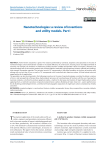
Nanotechnologies: a review of inventions and utility models. Part I
Статья научная
A brief review of patents is given. The research performed by scientists, engineers and specialists in the area of nanotechnologies and nanomaterials resulted in increased efficiency of construction, housing sector and adjacent fields of economy. For example, the invention «А method to produce titanium carbide nanopowder» refers to inorganic chemistry and nanotechnology and can be used to produce wear-resistant abrasive materials, high-temperature ceramic materials and coatings, high-strength composite materials. The technical result is TiC nanopowder in free-filled condition in the form of particles with average size no less than 30 nm, as well as TiC nanopowder with controlled ratio titanium-carbon. All that boosts technical opportunities for its application. The specialists can also be interested in the following inventions in the area of nanotechnologies: a method to obtain a mixture of micro- and nanoparticles of binary alloys, hydrocatalytic processes of recycling heavy oil fractions with the use of perspective nanosize catalysts, a method to produce graphene oxide, a method to decrease electrization of liquid hydrocarbons when applying them, a method to produce composite material boron-carbon, Modeling of static mixer (oil – water) performance for oil desalting and development test, a method of chromatographic separation of single layer carbon nanotubes by chirality and other.
Бесплатно
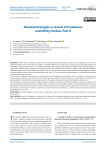
Nanotechnologies: a review of inventions and utility models. Part II
Статья научная
A brief review of patents is given. The research performed by scientists, engineers and specialists in the area of nanotechnologies and nanomaterials resulted in increased efficiency of construction, housing sector and adjacent fields of economy.For example, an invention «A method to produce metal-polymer nanocomposite materials with metal nanoparticles» refers to the method used in production of polymer articles with nanoparticles of silver or copper, widely applied in different engineering areas and used as antibacterial material. The invention provides environmental responsible and reagentless method to obtain polymer articles with metal nanoparticles which size is 5–15 nm and boosts rangeof polymers, including hemicrystalline and amorphous glass-like ones. The invention «Exfoliated polyurethane nanocomposite with polyfluoroalkyl groups» refers to design of composite and nanocomposite materials and can be used to create materials applied in polymer industry, in particularly, in production of solidcoatings for sport facilities, hydroinsulation and roof coatings, construction sealers and tribotechnical articles. The specialists can also be interested in the following inventions in the area of nanotechnologies: a method to obtain metal nanopowder from lead bronze wastes in distilled water, a method to produce collector plates, a water defluoridation method,an exfoliated polyurethane nanocomposite with polyfluoroalkyl groups, amultifunctional grease lubricant for heavy loaded friction joint, a thermostatic system to perform nanocalorimetric measurements, a self-hardening composition based on polydimethylsiloxane et al.
Бесплатно
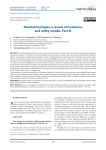
Nanotechnologies: a review of inventions and utility models. Part III
Статья научная
The article provides an abstract review of patents. The results of creative activity of scientists, engineers and specialists, including inventions in the field of nanotechnology and nanomaterials, being implemented, allow achieving a significant effect in construction, housing and community services, and related sectors of the economy. For example, the invention «Raw mixture for production of fine-grained polymer concrete modified by microsilica» refers to construction and can be used in manufacture of nanomodified concretes based on potentially chemically reactive coarse and/or fine filler for transport, industrial and civil construction. Modification of cement stone structures by means of microsilica made of silica production wastes and acrylic dispersion will make it possible to intensify hydration of binder, to reduce cement consumption and to increase strength characteristics of final product compared to traditional concrete mixtures. The invention can be used to produce concrete articles and structures, flagstones, decorative borders, to arrange top layers of road beds and to repair them when it is required, as well as to fill cracks and as a filler in sealing joints. The specialists can also be interested in the following inventions in the area of nanotechnologies: nanomodified high-strength light concrete, combined heat-insulating system, composite layered self-healing material, a method to produce metal/carbon nanocomposites, an electrochemical method to produce nanosized powder of metal silicide, a method to produce metal-polymer nanocomposite materials with metal nanoparticles et al.
Бесплатно
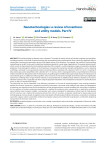
Nanotechnologies: a review of inventions and utility models. Part IV
Статья научная
The article provides an abstract review of patents. The results of creative activity of scientists, engineers and specialists, including inventions in the field of nanotechnology and nanomaterials, being implemented, allow achieving a significant effect in construction, housing and community services, and related sectors of the economy. For example, the invention “Heat-insulating material based on air gel” can be used to obtain heat-insulating materials for a wide range of applications. The required technical result, which consists in improving the thermal insulation properties of the material in a wide temperature range, increasing the absorbing properties of electromagnetic radiation in the IR spectrum, increasing the mechanical strength and flexibility, as well as reducing crumbling, is achieved in an air gel-based material containing a fibrous substrate with a density of 0.001–0.1 g/cm3, consisting of silica and/or glass and/or basalt fibers with a diameter of 0.1–5 microns, which is impregnated with an air gel obtained on the basis of silicon dioxide from alkoxysilane with the introduction of a gelling agent and followed by supercritical drying. The introduction of nanomaterials gives an additional reinforcing effect, which increases the mechanical strength of the final material and significantly reduces the crumbling of the air gel. The final material can be provided with an additional layer of fibrous substrate to increase its vibration resistance. This is especially true when using the proposed material for civil and industrial construction in seismically active zones, as well as in aircraft and rocketry. The specialists can also be interested in the following inventions in the area of nanotechnologies: nano-coating protection method for electrical connectors, preparation method of nanometric size metal oxide additives that reduce the temperature of sintering, raw material mixture for the manufacture of fine-grained polymer concrete (modified with microsilica), installation for the synthesis of carbon-containing nanomaterials, a method for producing silver nanoparticles, a method for producing nanocrystalline cubic tungsten carbide, a composition with carbon nanotubes for obtaining a carbon blank for high-density SiC/C/Si ceramics and a method for producing articles from SiC/C/Si ceramics, composite membrane for drying natural and technological gas mixtures based on graphene oxide intercalated with hydroxylated fullerene derivatives, compositions containing nanometric copper, carbon-ceramic fiber-reinforced composite material and a method for its production, a method for producing nanoparticles of aluminum oxide et al.
Бесплатно

